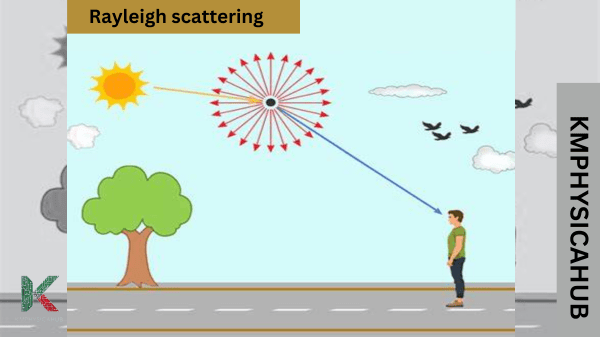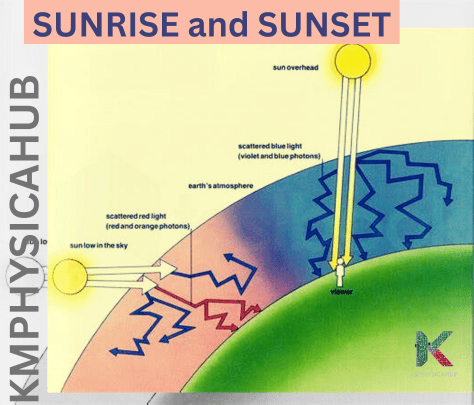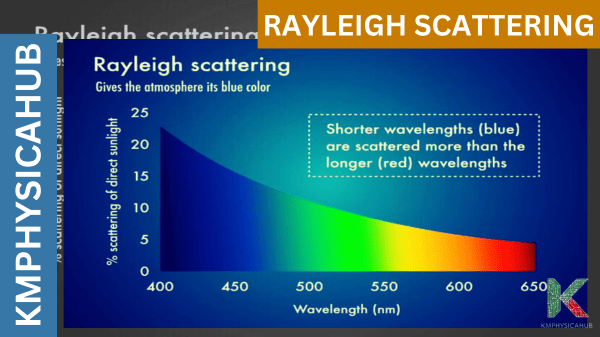Decoding the Blue Sky: Rayleigh Scattering, Color Perception, and More
Anyone who has looked up at the sky on a clear day has surely been captivated by the shade of blue present there, which poets, scientists, and common people have wondered and discussed for centuries. Thus, although observing beauty in things such as a clear blue sky can lead to art and awe, such a sight is underpinned by the properties of light and atmospheric science. At the core of this reasoning is the concept referred to as Rayleigh scattering which is named after the English mathematician and physicist Lord Rayleigh, who came across this occurrence in the nineteenth century.
Why does Sky appear Blue?
The sky appears blue as a result of the theory called Rayleigh scattering. During sunny weather, sun light that penetrates the Earth’s outer atmosphere is scattered in many directions by gases and dust particles. Blue light reflects off the gases in the atmosphere and thus, the sky appears blue because blue light has the long wave length as compared to other colors.
At the level of the horizon, or slightly above it, the sky may become lighter blue or white. This is because during the sunrise and sunset, Sun sends out its light through a lot more atmosphere hence scattering lots of blue light and letting the red and yellows show through. Thus, the issue is all in how light behaves within our atmosphere.

Explanation:
- Sunlight Composition:
Sunlight appears white to our sight, but in reality it’s a mixture of all the seven rainbow colors. If it is passed through a prism, it will be dispersed into the light spectrum containing different colors.
- Scattering by Air Molecules:
When the sunlight gets to the Earth’s atmosphere, it comes into contact with air molecules that are one micron or less in size. These molecules actively reflect light in all possible directions. Blue light is of short wavelength and is thus responsible for the scattering of light to a larger extent than other colors. As such, blue color is mainly perceived in the sky throughout the day time as opposed to other colors.
- Sky Color Variation:
Towards the line, as seen in the image, the background transitions to a lighter blue or white color. This occurs because light from low angles traverses through more air and hence experiences high levels of scattering. Additionally, Earth’s surface reflects and scatters light, mixing colors and reducing the intensity of blue.
- Red Sunsets:
Sunset light passes through even more of the Earth’s atmosphere. More blue light reflects while the reds and yellows start making it to our eyes meaning the room is warmer. Dust particles and aerosols are other elements that give the red tint on the sky during sunset.
As people often overlook, the sky is not blue because it reflects water – remember, it actually reflects scattered light.
Rayleigh Scattering
Rayleigh scattering is an interesting and phenomenon that occurs when the light is scattered by particles or molecules situated in the atmosphere.
What Is Rayleigh Scattering?
It is named after John William Strutt (Lord Rayleigh), the English physicist and is the process which is “an essentially elastic scattering of radiation”, where the particles are smaller than the scattered wavelength of the radiation.
This is because while passing through the earth’s atmosphere, sun light hits small air particles and then bounces back in all directions. Blue light, which has shorter wavelengths, scatter more thus giving the blue picture of the daytime sky.

How It Works:
The vibrating electric field of a light wave interacts with charges contained within a particle, leading to their motion occurring at an identical frequency. The particle becomes a small radiating dipole, and we see its scattered light.
Rayleigh scattering is applicable to particles that are small in comparison to light wavelengths and are optically “soft” with a refractive index close to 1.

Cause of Rayleigh scattering:
The predominant cause of Rayleigh scattering is the electric polarizability of the particles. When the electric field of a light wave acts on charges within a particle, they move at the same frequency, creating a small radiating dipole. We perceive this scattered light as the blue color of the sky during the day.

Historical Context:
In 1869, John Tyndall discovered faintly blue-tinted light scattering off nanoscopic particulates. Lord Rayleigh was able to quantify this effect in water droplets and advanced the explanation for the blue of the sky. His work stemmed from James Clerk Maxwell who had provided mathematical proof that light was of an electromagnetic nature.
How does Rayleigh scattering our perception of distant objects?
Rayleigh scattering significantly influences our perception of distant objects. Here’s how:
- Sky Color:
As we know that earlier blue light is more scattered than other colors of the spectrum. This happens because the light that enters our field of vision when we look at distant objects, diffused blue light prevails and, therefore, the sky looks blue. This effect is more pronounced during the day time.
- Distance Perception:
Rayleigh scattering affects our perception of distance. Objects farther away appear bluer due to increased scattering. This phenomenon contributes to the “aerial perspective” in art, where distant mountains or landscapes appear bluish or hazy.
- Sunset and Sunrise:
This is because when it is dawn or dusk, sunlight passes through more layers of the atmosphere and disperses even more blue light. Consequently, the Sun itself looks redder, while objects located at a distance acquire warm shades. This atmospheric effect only makes sunsets and sunrises more beautiful to behold.
- Visibility:
Rayleigh scattering reduces visibility for distant objects. The bluish haze caused by scattered light can obscure details and make distant mountains, buildings, or landmarks less distinct.
Why not the color of Sky Green or Purple?
Even if violet scatters much more than blue, our eyes will not be as sensitive to violet frequencies. Furthermore, the Sun radiates more intensity of blue light as compared to violet. Therefore, what we see in the sky is mainly blue instead of violet or green.
Other factors that affect the color of sky
Some other factors that can affect the color of sky apart from Rayleigh scattering are as follows:
Atmospheric Conditions: Various weather conditions affect the color of the sky. For instance:
- Pollution: Light pollution can disperse differently hence increasing the hazing of the skies.
- Dust and Aerosols: Scattering can be influenced by different particles – dust, smoke or even volcanic ash, which contribute to redder or grayish skylights.
- Altitude: Higher altitudes also make the sky appear darker since the density of the air is thin and scatters less light.
Altitude of the Sun: The Sun’s position affects sky color:
- Noon Sky: When the Sun is directly overhead (near noon), the sky appears bluer due to shorter light paths.
- Sunset and Sunrise: Because the sun is low in the sky, rays pass through a longer air mass and are more scattered and reddened, producing warm colors.
Ozone Layer: Ozone can also partially absorb some UV light. This absorption affects the color of the sky especially when one is at high altitude.
Twilight Colors: During twilight (dawn and dusk), the sky transitions through various colors due to scattering and the Sun’s position. Twilight hues range from blue to orange and pink.
Clouds and Weather: It can also be said that clouds scatter light in a different way. White clouds generally brighten up and make appearances while thick clouds absorb more rays and scatters more colors thereby changing the tint of the sky.
Rainbows: When light bounces inside the rain droplets, rainbows are produced. They display a range of shades of color against the background.
Sunset and Sunrise
When the sun is rising or setting, it is closer to the horizon and the light has to pass through a greater number of layers of the atmosphere to get to us. This suggests that blue and violet create a longer path, which makes them scatter away repeatedly while red, orange, and yellow are left behind. Consequently, the sky takes on vivid hues of red and orange, and the Sun itself appears redder.

Conclusion:
Finally, we will be able to understand why the sky looks blue primarily due to the scattering of sunlight by the molecules and particles in the Earth’s atmosphere. Rayleigh scattering redirects short waves like the blue and violet but by the way we see it and the ways in which the atmosphere absorbs light, it is blue that dominates.
This scattering function changes with respect to time and environmental conditions hence providing my overhead canopy in a dynamic and constantly changing manner. Taking the physical explanation could reduce the sentimentality of the blue sky a little but it leaves us with a profound mystery of Light and matter in the atmosphere making it doubly fascinating to question the mysteries of the nature.
FAQS
Q1: Define Rayleigh scattering?
A: Rayleigh scattering concerns with dispersion of particles with size much less than the wavelength of light and the short waves are scattered more than the long ones.
Q2: Why the sky appears blue?
A: The sky seemed to be blue because the short blue light waves of sunlight are scattered in many directions by the molecules of the Earth’s atmosphere in preference to all other colors.
Q3: Why don’t we see a violet sky despite violet light being scattered more than blue light?
A: While the violet light experiences even more scattering, human eye is most sensitive to the blue, and part of violet is also absorbed by the upper layer of the atmosphere, thus resulting the actual color being blue.
Q4: Why do sunsets and sunrises appear red and orange?
A: At sunrise and sunset, the sun light passes through more layers of atmosphere and this disperses short wavelength colored rays whereas the longer wavelength of red and orange are let through.
Q5: How does pollution affect sky color?
A: Pollution introduces larger particles that scatter light more evenly, often resulting in a less vibrant blue sky, making it appear whiter or grayer.
Q6: Do other planets have blue skies?
A: Some planets may have blue skies, depending on their atmospheres’ composition and the scattering effects. For example, Mars has a red sky due to its dust and atmosphere.

